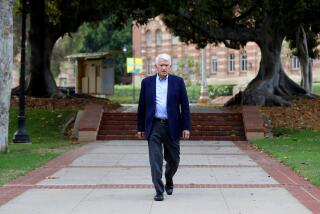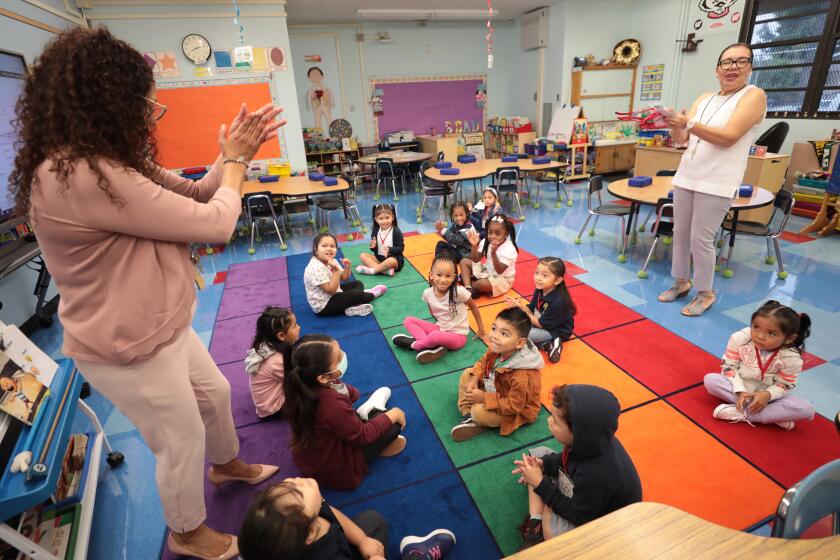Welfare Rules, Some College Plans on Collision Course
Lylee Smith thought she had mapped out a simple blueprint for personal and professional success: six units a semester at El Camino College over the next two years would leave just enough space for her part-time job and precious hours with her young children while eventually leading to the degree she has long sought.
But her careful planning may be in for an abrupt adjustment: As a single mother on welfare, her pursuit of a degree in office administration has placed her on a collision course with the advent of welfare reform and its work-first mantra.
Sometime during the next year, Smith’s course work will be evaluated--not for its rigorousness or her grade-point average, but to determine whether it will lead to immediate employment. If not, she will be asked to rethink her college program, increase her classroom hours or perhaps accept a full-time job, even if it pays minimum wage.
The prospect that large numbers of welfare recipients will be forced out of traditional college courses and into jobs or training programs is provoking alarm among many students and educators. At the same time, proponents of welfare reform see the changes as long overdue.
In the Los Angeles Community College District, where 15% of the student body is on public assistance, a substantial enrollment decline could dramatically alter the student body and result in the loss of state education funds based on the number of full-time students enrolled. But it is the potential loss of advantages gained through a broad education that administrators say they fear most.
“The ability of my existing students to complete their programs is a huge concern of mine,” said Los Angeles Community College District Chancellor Bill Segura. “They have already established themselves as students, have already made sacrifices and it would be tragic for them to have to interrupt their studies to get a job, just to get a job.”
But the extent to which society should subsidize welfare recipients in achieving their educational goals provokes a different response in those who support legislation that has imposed work requirements and time limits for those on aid.
“I don’t think California’s taxpayers should have to be paying welfare recipients to go to college and be full-time students,” said Assemblyman George Runner Jr. (R-Lancaster). “There are many people throughout history who have gone to school, worked at the same time and taken low-paying jobs to do that. Why should that be considered something wrong to do?”
*
The tightened education requirements stem from passage in 1996 of the landmark federal welfare overhaul, which gave states broad new powers to devise their own public assistance programs.
Under CalWorks, California’s welfare plan, current recipients must find work within two years, while new recipients are restricted to 18 months on aid. Counties have the option of extending the deadline for six months. Recipients can spend no more than five years of their lives on aid.
Students can remain in school while on public aid only if they are making satisfactory progress in an undergraduate or certificate programs that will lead to “self-supporting” employment. Education and welfare officials must come up with a list of approved programs on each campus by the end of January. Courses in accounting and computer programming are likely to make the list, while programs such as literature or prelaw may not.
Students must be engaged in a combination of education and work for at least 32 hours each week and can count class time, lab time and internships as part of the equation.
The apprehension of some educators is based on stark figures: Statewide, more than 140,000 community college students--10% of the student population--received public aid in the 1995-96 school year, according to the chancellor’s office of the California Community Colleges. In the nine-campus Los Angeles Community College District, 14,521 students out of 103,000 received welfare. On the Los Angeles Southwest College campus, welfare recipients made up 42% of the student enrollment; on the City College campus, 19%; on the East Los Angeles campus, 15%.
District officials estimate that welfare recipients account for about $29 million of the Los Angeles Community College District’s $233 million in revenue.
*
Some of them are referred to college for remedial and basic skills training through GAIN, or Greater Avenues for Independence, the primary welfare-to work program in each county. But the vast majority--in the Los Angeles district, 92%--are their on their own. Most qualify for financial aid, and studies have concluded that they tend to spend more hours in class than other students.
The 1996 welfare legislation was designed to transform the nature of public assistance in America and it is having a wide-ranging impact--setting up a potential clash between educators who fear plummeting enrollments and welfare officials under pressure to find work for large numbers of their clients.
Although the two groups have frequently worked in concert, the new mandates of state and federal welfare legislation have thrust them into a far more intimate partnership than ever before.
Over the next few months, teams of educators, business leaders and welfare officials will undertake everything from the redesign of college curriculum to analyses of regional labor market demands and outreach to local employers.
Those charged with working up lists of college programs that meet the new work-oriented education goals say they are making progress but concede that there are some conflicts of opinion.
College officials say they are seeking a broad definition of such goals and want to ensure that students can obtain degrees. Welfare officials, on the other hand, are focused on moving recipients quickly into work.
“We don’t have the luxury of time or large amounts of money to engage in long-term educational programs prior to them gaining employment,” said John Martinelli, GAIN administrator for the Los Angeles County Department of Public Social Services. “Frankly, CalWorks is not intended to support people while they pursue college degrees. It’s a fine and admirable goal, but not what public assistance is here to do.”
Many educators have a slightly different take.
“Our primary concern is to maintain education access to everyone who needs it because community colleges are known for providing opportunity to people who otherwise wouldn’t have a chance,” said Connie Anderson, the state community college system’s CalWorks coordinator.
Not all educators believe that welfare changes will have a serious effect on most colleges.
“It doesn’t sound like a major threat,” said Arthur Cohen, director of the Educational Resources Information Center/Clearinghouse for Community Colleges, a UCLA center that researches issues affecting community colleges.
He said not everyone is suited for college and pointed out that the need to work does not preclude college. “If that were the case, community colleges would lose half their enrollments,” he said.
Lylee Smith is hoping that her studies, which entail bookkeeping and other office skills, will pass muster. But she fears she will have to increase either her work or school hours to fulfill the requirement that she be engaged in 32 hours of work and school each week.
In and out of school since 1995, the 30-year-old Venice resident is currently a secretary at a Gardena real estate agency, where her part-time salary and $565 monthly welfare grant are just enough to make ends meet. Her 10-year-old daughter and 7-year-old son are involved in after-school programs, so she has no child-care concerns now but might if she were required to work or be in school extra hours.
“I would love to go to school full-time, but I have to be realistic,” she said. “They have cut my aid down so much that I couldn’t live. But as much as I want to finish school, if I could find a job that would pay me enough money and give me benefits, that would be my priority.”
Many educators say they are concerned that vocational programs will provide little training beyond that required for low-paying, entry-level jobs.
“Studies indicate that what employers say they want are employees with good sense, good math and verbal skills and those who can think critically,” said Jack Friedlander, vice president for academic affairs at Santa Barbara City College. “Most of those skills you get in a broader, general education, and the contradiction is that welfare reform is taking us in the opposite direction.”
But, as with other aspects of welfare reform, the education changes represent uncharted terrain, and neither college administrators nor welfare officials are quite sure what to expect.
While educators fear losing some full-time students, they could also see a boost in the overall numbers of welfare recipients as they enroll in basic skills classes, vocational and occupational training, job search programs and post-employment programs such as financial management and parenting workshops.
Indeed, welfare officials say community colleges will play a major role in allowing welfare clients to upgrade their skills and graduate from low-paying, entry-level jobs to better-paying jobs and careers.
Martinelli cited as an example a $20-million state-funded project to upgrade the skills of welfare recipients working in low-wage jobs. In Los Angeles, companies such as Carl’s Jr., Taco Bell, Sears and Kmart have signed onto the program, which will be located at El Camino College and have 500 employees initially.
College administrators also concede that the force of welfare change will speed innovations that might otherwise have taken years.
Schools are shifting to more evening and weekend classes to accommodate students who must work and are developing short-term, compressed training programs, on-line and video classes and open-ended courses in which students will work and complete programs at their own pace.
In the end, said Segura, educators must remain key players as some long-standing educational practices are transformed. “We didn’t write the [welfare] legislation, but we own the territory and we have to be partners,” he said.
More to Read
Start your day right
Sign up for Essential California for news, features and recommendations from the L.A. Times and beyond in your inbox six days a week.
You may occasionally receive promotional content from the Los Angeles Times.







